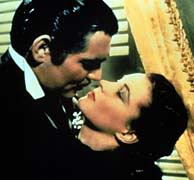All the prominent award systems in the entertainment industry are subject to complaints about winners, nominations, and perceived snubs. The Academy Awards are no different, with particular concerns this year that all 20 nominated actors and actresses are white for the second straight year, triggering the #OscarsSoWhite campaign and commitments from The Academy to diversify the membership that votes on nominations.
The Academy's full membership votes to nominate Best Picture, while other categories are only nominated by Academy members in that category – actors voting for actors, directors for directors and so on. With ranked choice voting, voters rank their choices, and in the five-nomination categories it requires roughly 17% of first choices to win. Any nominee securing more than this victory threshold has a share of each vote count for the second choice on the ballot, and after all such surplus votes are distributed, last-place candidates are eliminated, and their ballots added to the totals of their second choice. At the end of the count, nearly everyone helps nominate someone in their category. (
As we’ve explained, Best Picture was changed a few years ago to a rather puzzling form of ranked choice voting that can result in the nomination of movies with a much smaller base of passionate support.)
This year’s nominees reflect diverse appreciation for performances from veterans and rising stars. In the Best Actress category, nominees include well-known previous winners (Cate Blanchett and Jennifer Lawrence), new rising stars (Brie Larson and Saoirse Ronan) and veteran Charlotte Rampling. Rampling’s 45 Years is a low-budget film just being released to American audiences, but enough fellow actors appreciated her performance to elevate her over better-known actresses.
Best Director nominees went to a big budget blockbuster (George Miller for Mad Max: Fury Road), last year’s winner (Alejandro G. Iñárritu for The Revenant), and the two best picture frontrunners (Adam McKay for The Big Short and Tom McCarthy for Spotlight), but also in a surprise to Lenny Abrahamson, the director of Room. Abrahamson almost certainly would lost in a winner-take-all nomination process, but had a passionate base of support that could earn him a nomination with ranked choice voting.
#OscarsSoWhite
A 2012 analysis by the Los Angeles times, indicated The Academy members are overwhelmingly white (94%) and male (76%). Overall, since 2000 African Americans garnered 10 percent of acting nominations and 15 percent of the wins, despite under-representation of African Americans on screen (studies suggest about 9 percent of the characters onscreen have been black). Other racial minorities have less history of high-profile performances and nominations. Merle Oberon, nominated for Best Actress in 1935, is the only Asian woman nominated for the award. While African Americans have had a history of being nominated in the past two decades, the #OscarsSoWhite campaign challenges the lack of representation for people of color throughout the industry by raising concerns with the nominees of the last two years.
This year, the only person of color nominated for a major award is director Alejandro González Iñárritu who won the Oscar last year for Birdman. No movies made by, starring, or about African Americans received nominations for any of the major awards (Best Picture, Actor, Actress, Director), even Creed and Straight Outta Compton that were critics' and fan favorites.
There was more racial diversity in other categories. As explained in a revealing piece by Southern California Public Radio, voters in the animation category have far more women and people of color than many other categories, dating back to hiring practices by Walt Disney decades ago, and their nominees reflect it. In the animation category, women and people of color regularly are nominated and win including most recently Big Hero 6’s win last year and this year’s nominations for Inside Out and When Marnie Was There. The diversity in the animation category demonstrates how, when a portion of Hollywood itself is more diverse - both in who gets to work and who gets to vote - Oscar nominations will more regularly reflect that diversity, thanks to RCV.
Diverse Voices, a Diverse Electorate, and Diverse Winners
Raked choice voting (RCV) is in fact the most fair and representative voting method available to the Academy. When used to elect multiple candidates, RCV is great at representing a diversity of voices in a diverse voting population. We can look at other RCV elections to see it impact.
Cambridge, Minneapolis, the Bay Area, and countries such as Ireland and Australia all use forms of ranked choice voting for many of their elected bodies. Cambridge is uses the multi-winner system similar to the Academy’s system for nominations. After the 2013 elections,
as explained by FairVote’s Andrew Douglas, the Cambridge City Council was the most representative it had ever been, with an African American, Arab American, Asian American, and a Latino American serving alongside five other colleagues who received support from a diverse (racial and political) array of Cambridge residents. The majority of voters have the power to elect a majority of seats, but minority voters of all kinds earn their fair share.
RCV and the Academy Going Forward
It’s encouraging that The Academy is focusing on increasing the diversity of its voting population, with others focusing rightly on diversity within the industry as a whole, including who gets to make movies, gets hired for technical work, and gets onscreen. The Academy’s reforms tackle its membership, governing bodies, and voting eligibility. Three new seats will be created on the Governing Board, and The Academy will launch “an ambitious, global campaign to identify and recruit qualified new members who represent greater diversity,” though the specifics of this effort remain unclear. In addition, some members of The Academy may have their voting rights revoked after ten years of inactivity. The Academy argues this will ensure active and diverse members will have a stronger voice.
As Viola Davis said during her Best Actress Emmy acceptance speech last year, “The only thing that separates women of color from anyone else is opportunity.” If these reforms work as planned, women (and men) of color will hopefully be given greater opportunity to create great art and be recognized for it. Ranked choice voting works to increase representation. The Academy's continued use of fair voting ensures that all voters participate in a meaningful election to elect a candidate they prefer.


.png?1452811831)
